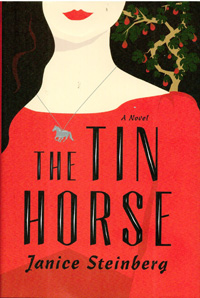The Tin Horse by Janice Steinberg, Random House © 2013, ISBN 978-0-679-64374-6; 336 pages, $26.
By Donald H. Harrison

 SAN DIEGO—There are two mysteries to be solved in The Tin Horse by Janice Steinberg, who contributes articles on books and dance to San Diego Jewish World.
SAN DIEGO—There are two mysteries to be solved in The Tin Horse by Janice Steinberg, who contributes articles on books and dance to San Diego Jewish World.
One mystery is the central story of this novel. Whatever happened to Barbara, the twin sister of the protagonist Elaine Greenstein Resnick? One day she just disappeared. Where did she go and why? Obviously, I can’t tell you without spoiling the book for you.
But the other mystery I’m free to ruminate about in print. I send an appeal to all the librarians out there who are familiar with book classification theory, because, I’ll admit, I’m stumped. Should we call this novel a “mystery novel?” It keeps us reading and reading hoping to find out what happened. Some readers will come up with their own theories before the novel reaches its denouement.
Nevertheless, this novel is not only a mystery.
It also is a meticulously researched story about the Boyle Heights section of Los Angeles which had been a Jewish neighborhood, filled with immigrant families who somehow avoided—or at least exchanged—the sweltering ethnic neighborhoods of New York and Chicago for the mild sunshine and citrus and flower scents of Los Angeles. The novel reconstructs very credibly the important events in Los Angeles, such as the Long Beach earthquake, as well as the ongoing developments in Hitler’s Europe that greatly impacted Boyle Heights’ population. So should we call this novel “historical fiction?”
It is also the story of two fraternal twin sisters growing up and competing for the love of their mother, and the love of the boy next door. One sister attracts him with her mind, the other appeals to more basic instincts. So should we call this a “coming of age story?”
The competitions between Elaine and Barbara are not the only family matters deeply probed in this story about the Greenstein family. Why did Mama leave her family in Europe? Why did she marry Papa? And what about Zayde? Did he really make a tin horse necklace to romance the beautiful daughter of a farmer, during the days in the old country when Jewish boys were not even supposed to look at Christian girls? Is it true that was the reason he had to leave the old country? What are people’s real motivations? Should we call this a “psychological novel?”
When people tell stories about themselves, they don’t usually fabricate them from out of thin air. No, instead they snip a piece of truth from here, wishful thinking from there, and perhaps a little regret from somewhere else. Then they sew for themselves a new garment. Could that be what Barbara did? Or Elaine? Or Mama? or Zayde?
Author Steinberg’s fertile mind has woven mysteries within mysteries. This novel, navigating so many thought streams, prompting so much speculation, was, for me, a delight to read. Perhaps that was because it was a historical fiction, coming of age, psychological mystery.
*
Harrison is editor of San Diego Jewish World. He may be contacted via donald.harrison@sdjewishworld.com
I love your beautiful prose. I can hardly wait to read the book, especially, since I grew up in Boyle Heights after moving, at age nine, from Chicago.